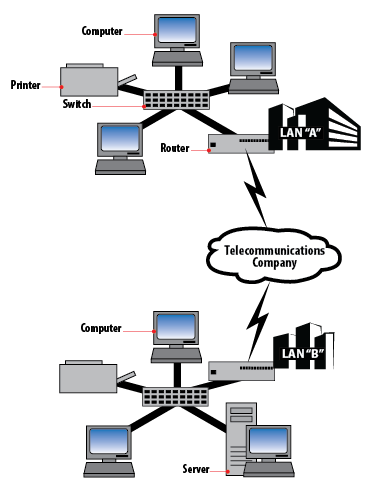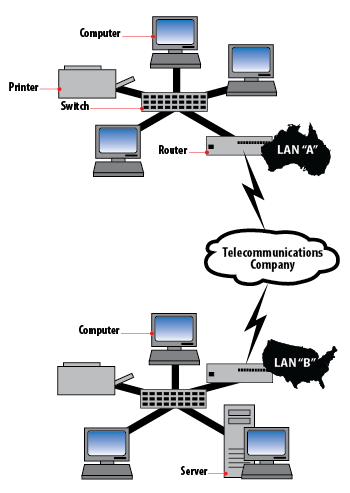Networks
The underlying structure of communications is a network. A network consists of two or more computers that are linked together to provide shared access to file servers, printers, or to electronic communications. The computers can be linked through phone lines, cables, satellite, radio waves or infrared light beams.
There are two basic types of networks, they are Local Area Network (LAN) and Wide Area Network (WAN). Both networks can also be wireless and are designated as WLAN and WWAN respectively. A third network type that you may see references to on occasion is the Metropolitan Area Network (MAN).
Local Area Network (LAN)
As the name implies, Local Area Networks are networks that cover a relatively small physical area — a home, office or small groups of buildings like a school. A LAN network rarely has computers more than a mile apart. Generally one computer is designated the file server. The file server stores network software and any other software shared by the computers attached to the network. Computers connected to the file server are called workstations. Advantages of LANs are they typically have higher data-transfer rates than WANs, and they do not need leased telecommunications lines.
Figure 1 LAN Network – Linking individual workstations, usually less than a mile apart

Metropolitan Area Network (MAN)
A Metropolitan Area Network usually spans a city or large campus. It falls between a LAN and a WAN in geographic scope. MANs usually interconnect a number of LANs, and provide connection to the internet.
Figure 2 MAN Network – typically linking LANs across a city/campus

Wide Area Network (WAN)
WANs are used to connect LANs and other types of networks together. They cover larger geographic areas and transmit using dedicated cabling or satellite uplinks to connect the network. The purpose of the WAN is to allow computers in one location to communicate with users or computers in other locations. Some WANs are built by individual organizations, others may be established by Internet service providers. WANs are complicated and use multiplexers to provide LANs and MANs with connections to the Internet. WANs are largely built using leased communication lines, however other options are available including Circuit switching, Packet switching, and Cell relay.
Figure 3 WAN Network – linking LANs and other networks over large areas

There are advantages and disadvantages to each.
Leased line –
Advantages: most secure
Disadvantage: expensive
Circuit switch – Dedicated circuit path is created between end points. Ex. Dialup connection
Advantages: less expensive
Disadvantages: call setup
Packet switch – Variable size packets of data are transported via a shared link across a carrier internet connection
Advantages: Bandwidth is allocated dynamically. Data is transmitted in packets with destination information and error checking. It improves the efficiency of the overall network. Typically is more economical. Many messages can be sent quickly to various destinations.
Disadvantages: shared link
Cell relay – Fixed length packets of data transported across virtual circuits
Advantages: best for simultaneous use of voice and data
Disadvantages: overhead can be costly
Regardless of the whether you are connected to a LAN or WAN to users there will not appear to be much difference.
